WW1 German Prussian FaschinenMesser M. 1864 u. /M. Short Sword 1871 Unit Mark
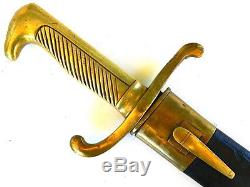
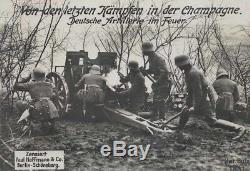
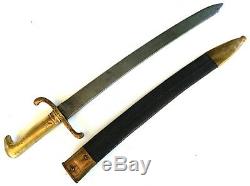

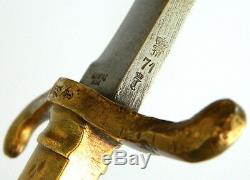
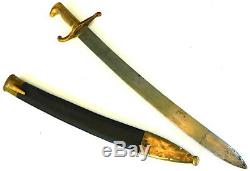

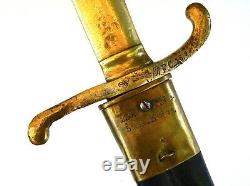
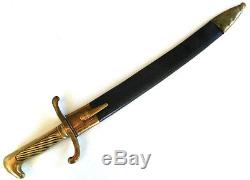
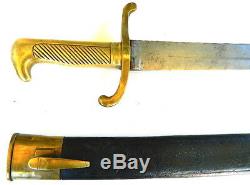
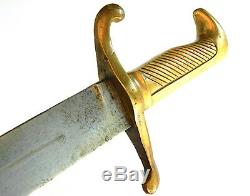
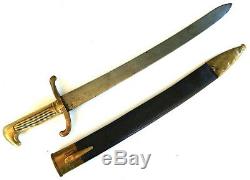

SHORT SWORD AND ORIGINAL SCABBARD MANUFACTURED IN 1871 BY V. JUNG & SOHN IN SUHL WITH UNIT MARKS OF TWO ARTILLERY UNITS ON SWORD AND SCABBARD. This German / Preussische FaschinenMesser M.
Was one of a number of short Faschinenmesser Artillery, Infantry Pioneer, Garde-Regiment zu Fuß (fusilier and guards swords) in use with the armies of the various German States (Prussian, Bavarian, Saxon, Wurtemburger Baden amongst others) between the end of Napoleonic Wars and the end of WW1. This sword is marked with a number of unit marks from various Prussian artillery regiments. This particular example is a rare example of a Preußische. Manufactured in 1871 by V.
Jung & Sohne of Suhl as indicated by the stamp on the obverse ricasso. According to Faschinenmesser: Preußen, Sachsen, Bayern, Württemberg by Peter-Michel Wolfgang p. 156, the Prussians captured la significant number of the French infantry sabre briquet during the 1813 Befreiungskrieg. Some of these were re-issued as they were to Prussian troops, others were shortened and given new grips to become the Faschinenmesser M. The Preußische FaschinenMesser Modell 1864 was a development from this M. 1839 , but using the grip from the Füsilier-Seitengewehr M 1860. Iinitially, the shortened blades of captured French sabre briquet were used but later on purpose-made and obsolete blades (from earlier Faschinenmesser) were utilised.The correct German / Prussian designation of this particular sword is Preußische. Which accurately reflects its employment as an issue brass hilted pioneer short sword with ridged brass grip and a straight wide profile blade fitted with a black leather and brass scabbard. Shawn Gibson of the Society of American Bayonet Collectors describes how the term Faschine was originally used to describe the stick bundle used to reinforce field works and that, troops in the 18th. And 19th Centuries, the collection and manufacture of these Faschine bundles was the task of specialist sapper (pioneer, artillery) and engineer troops. He describes how Revolutionary War sites in the US often turn up a peculiar hooked knife called a faschine knife and that the word while German was used in most European languages.
Gibson explains that the faschinenmesser is the German/Austrian version of a knife for cutting faschine and that by the mid 19th century it had become become a combination tool/short sword with a wide heavy chopping blade usually issued to engineering or pioneer troops. Was the short sword variant issued to all arms of the Prussian Army. Artillery and Infantry regiments maintained Pioneer sections within their establishments to undertake the heaviest work including clearing paths through difficult terrain (including forests), establishing and clearing defensive obstacles and constructing gun positions. As a mark of their status and as a practical tool they were issued with this robust and capable weapon. These weapons remained in service for a considerable period of time up until the end of the First World War. This particular short sword was most probably in use for at least 50 years. Attached to this listing is a photograph of some Prussian Gunners on the Western Front in WW1 showing the commander, gun layer, and loader carrying Preußische.This particular example, which unusually still retains its original brass and leather scabbard, has the unit marks of two artillery units on the rear face of the scabbard locket and an artillery transport unit on the crossguard. The scabbard is marked with both a cancelled and now unreadable artillery unit 23. As well as the stamp.
And the weapon (waffe) number 23. The crossguard is stamped R. Indicating that it was issued to Reserve-Fuhrparkkolonne 16 as weapon (waffe) number 94. A number of additional marks are also visible on the sword crossguard and the back edge of the blade. These are the Prussian Crown ownership mark with the letters FW for King Friedrich Wilhelm IV (1795 - 1861) and the date of acceptance 71 for 1871. The astute reader will realise that the acceptance date and a royal monogram for a monarch who died 10 years before is unusual but not unknown. As Chris Dale, in his excellent online reference site, points out Naval Füs Sg 1860 bayonets were still stamped with his monogram. For sometime after his death. Appears to have used a blade from an M. 1839 which is why its stamped with the monogram of a dead king and an inspectors Fraktur (Crown over N) from his successor. This is a first rate Preußische. Its fitted with a straight wide profile steel blade fitted with its original brass and leather scabbard which is in very good condition with only one missing staple (see pictures). Both sword and scabbard show clear evidence of use consistent with age and employment and are heavily patinated. This sword was probably in service with different units for at least 30 years and probably over 50 years and displays evidence of that use. That said, its a first class example of a scarce sword almost never found with its original scabbard. From Australia, this is a very good example of a rare and highly sought after. Short sword displaying clear evidence of use up to WW1. Rarely found with its scabbard this is a variant not often seen on e-bay. All up, a cracking sword, and a really evocative piece of First World War history. The items I list on ANZACBLADE e-bay are also listed on my website of the same name.The item "WW1 German Prussian FaschinenMesser M. Short Sword 1871 Unit Mark" is in sale since Sunday, January 28, 2018. This item is in the category "Collectables\Militaria\1914 - 1918 (WWI)".
The seller is "anzacblade" and is located in Griffith, ACT. This item can be shipped worldwide.
- Country: Germany
- Product Type: Sword
- Authenticity: Original
- Era: 1800s

